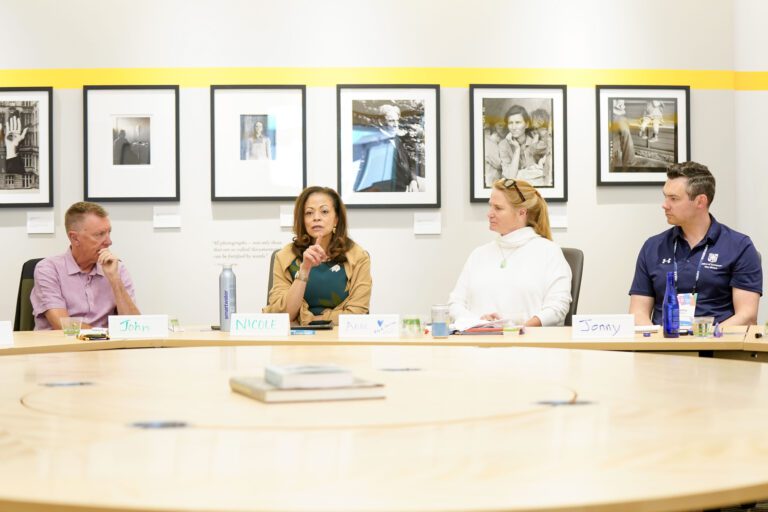Q&A: Behavioral Science and 2Gen
Throughout 2015, Ascend is hosting a series of webinars in which we go in-depth with Network Partners and leaders in the field working in specific content areas to build evidence for two-generation solutions.
Behavioral science and economics are growing fields that have important implications for the 2Gen movement. The axis of the two fields focuses on the effects of psychological, social, cognitive, and emotional factors on the economic decisions of individuals and institutions and the consequences for returns and resource allocation. Simply put, being poor makes it harder to get ahead and taxes the ability of families with low-incomes to do many of the things upper-income families take for granted. On November 3, 2015, Ascend and ideas42, a leading organization in the behavioral science space, hosted a webinar entitled “How Big is Your Suitcase?” in order to further explore connections between behavioral science and 2Gen work. The webinar highlighted key insights from the ideas42 white paper, Poverty Interrupted, and discussed how choices around language, design, and timing affect outcomes for families served in the 2Gen field.
The webinar’s participants posed many questions for the presenters. Below are answers to the questions that were not addressed during the webinar. To view the webinar recording, click here.
Presenter Biographies
Allison Daminger is a senior associate at ideas42, where she currently focuses on poverty alleviation and promoting economic mobility. Prior to joining the team, she worked as a program manager for The Food Project, a Boston-based nonprofit devoted to promoting urban agriculture and increasing access to fresh food. Allison holds a BA from Princeton University, where she majored in anthropology and global health. As a part of her studies, she conducted ethnographic research on (non)adherence to HIV/AIDS medication in Guatemala City. Outside the office, Allison can often be found cooking with obscure vegetables and exploring new neighborhoods with camera in hand.
Teis Jorgensen is an associate at ideas42. His work focuses on consumer finance and applying behavioral economics to family planning and reproductive health. Teis has worked as a research assistant to Professor Todd Rogers, Harvard Kennedy School, and Professor Mahzarin Banaji, Harvard Department of Psychology. He has done research on a diverse range of topics including environmental consumerism, institutional corruption, and the value of a reminder. He has a Bachelor of Arts in Economics from Harvard College. In his free time, Teis writes children’s poetry and performs improvisational comedy.
Q&A
How can behavioral science lessons be used for engaging with or serving more effectively non-custodial parents?
Without knowing more details about the situation, our best advice is to think hard about what the problem might be for non-custodial parents in your particular programmatic context. Are they expressing interest in being more involved in their children’s lives, but failing to take a first step? Are they starting out in a program or service and then dropping off at some point? Are they failing to follow through on a particular commitment? Each of these is a behavioral problem, where there’s a gap between what people want or intend to do, and what they’re actually doing. Defining that gap must precede diagnosing its cause and designing a solution.
In each of the hypothetical scenarios above, any number of contextual features might be influencing parental behavior. These factors might include services that conflict with work schedules, programs that are inaccessible by public transit, or problematic framing and presentation of parental engagement. This last feature can be a powerful deterrent to parents: if we treat non-custodial parents with suspicion, hostility, or a presumption that they don’t want to (or oughtn’t) be involved with their children, those implicit signals can be quite aversive. Depending on the context we might suggest an array of solutions, which could include things like transportation supports, motivational interviewing techniques, or even hiring fellow non-custodial parents as staff.
How do you manage the limited attention issues when there is a need to provide new information about new ways of solving their problems or even new tools that they otherwise may not be aware of?
If you have a built-in channel to communicate with people, attending to the design of those communications can mitigate limited attention, an inescapable feature of human cognition. When designing communication, it’s important to consider several variables, including clarity, quantity, and timing. Your goal should be to make it as easy as possible for participants to extract the most important information—usually, whatever action is required or requested—from a flyer, email, or in-person meeting. This can start with removing unfamiliar terminology and making sure documents are available in the participant’s language and written in plain language. Of course, it’s very difficult for an “insider” to assess clarity, so external feedback, particularly from the intended audience, should be built into the process for creating any important communication.
Prioritization and timing are also key. In particular, it’s important to increase the salience and actionability of information that participants will need in order to take action. It’s best to offer information at a moment when people can act right after forming an intention. Is there an immediate path to enrollment in a program once they’re informed about it? Can a staff member set an appointment with a partner agency during a consultation, rather than giving a referral? Are people receiving text message or email reminders at a time when they’re free?
Similar principles apply when considering the right moment to introduce new information or tools. When do your constituents have high-bandwidth moments, and how are you leveraging those moments to their advantage? People will be better able to take in new information when they aren’t distracted, tired, or hungry, so maybe it makes sense to avoid conveying important information at the end of a long work day, or around the time people might be scrambling to pay rent.
How did ideas42 identify the organizations in the white paper “Poverty Interrupted,” and what efforts are ongoing with those organizations?
Our goal was to connect with organizations that varied widely in terms of geographic location, size, domain, and target population. Given our focus on two-generation strategies, we also sampled heavily from the Aspen Ascend network. Our initial landscape scan centered on organizations that had been recognized or celebrated for their innovative work on poverty and related issues. We wanted to understand both their successes and ongoing challenges, in order to identify the best opportunities to apply behavioral science to the problem of intergenerational poverty. In many cases, the practitioners we talked to pointed us to other organizations they work with or admire from afar, and our initial list grew exponentially.
ideas42’s ongoing efforts with these organizations run the gamut from the occasional email update to active pursuit of a long-term partnership. Our hope is that the Poverty Interrupted white paper is just the beginning of a long-term anti-poverty initiative, and we’re looking forward to combining forces with practitioners and policymakers around the country in the years to come.
How can practitioners better communicate the concept of “scarcity,” and also ensure we acknowledge disparities in race, class, and gender when using behavioral science tools?
The best strategy for communicating about scarcity will depend on your audience, but most people “get it” quickly when we cite everyday examples. For instance, almost everyone has missed a meal and found himself or herself unable to think about anything other than food. Similarly, who hasn’t scrambled to meet a work or school deadline and then seen other routines (housekeeping, exercise, family time) suffer as a consequence? Once you have a personal example in mind, it’s easier to put yourself in the shoes of someone experiencing a different or longer-term form of scarcity. This empathetic understanding is critical because behavioral science focuses on universal (or near-universal) human tendencies. Scarcity doesn’t just affect people living in poverty: anyone who experienced the context of chronic scarcity, regardless of their socioeconomic status, would respond similarly.
At the same time, we should all remember that race, class, and gender shape the contexts we find ourselves in. The resources at our disposal, the ways that people respond to our actions, and even our expectations for ourselves tend to vary based on circumstances outside of our control. Furthermore, forces like implicit bias and stereotype threat can affect the way we perceive and treat each other (and ourselves) in ways that aren’t always apparent. When the downsides of scarcity’s effects manifest themselves, the impact of these other forces might be exacerbated.
Therefore, when applying insights from behavioral science, it’s very important that we tailor our interventions to the appropriate context. One size doesn’t fit all when it comes to designing programs and making policies that achieve maximum impact, and that’s the reason ideas42 spends considerable time defining problems and diagnosing their causes before we move on to the design phase. Thankfully, there is promising evidence that behavioral tools can be used not just to mitigate the effects of scarcity, but also to overcome some of these other barriers.
Where would Ideas42 like to be in five years?
One of our primary goals as an organization is to achieve widespread impact: we want to use behavioral science to make a difference in millions of lives worldwide. In five years, we will hopefully have made considerable progress toward that ambitious aim by scaling successful interventions across the country and around the world.
Related Posts



